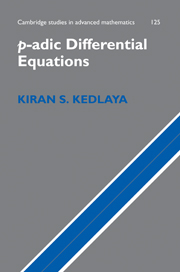Book contents
- Frontmatter
- Contents
- Preface
- 0 Introductory remarks
- Part I Tools of p-adic Analysis
- Part II Differential Algebra
- Part III p-adic Differential Equations on Discs and Annuli
- 8 Rings of functions on discs and annuli
- 9 Radius and generic radius of convergence
- 10 Frobenius pullback and pushforward
- 11 Variation of generic and subsidiary radii
- 12 Decomposition by subsidiary radii
- 13 p-adic exponents
- Part IV Difference Algebra and Frobenius Modules
- Part V Frobenius Structures
- Part VI Areas of Application
- References
- Notation
- Index
12 - Decomposition by subsidiary radii
Published online by Cambridge University Press: 05 August 2012
- Frontmatter
- Contents
- Preface
- 0 Introductory remarks
- Part I Tools of p-adic Analysis
- Part II Differential Algebra
- Part III p-adic Differential Equations on Discs and Annuli
- 8 Rings of functions on discs and annuli
- 9 Radius and generic radius of convergence
- 10 Frobenius pullback and pushforward
- 11 Variation of generic and subsidiary radii
- 12 Decomposition by subsidiary radii
- 13 p-adic exponents
- Part IV Difference Algebra and Frobenius Modules
- Part V Frobenius Structures
- Part VI Areas of Application
- References
- Notation
- Index
Summary
In the previous chapter we established a number of important variational properties of the subsidiary radii of a differential module over a disc or annulus. In this chapter, we continue the analysis by showing that, under suitable conditions, one can separate a differential module into components of different subsidiary radii. That is, we can globalize the decompositions by spectral radius provided by the strong decomposition theorem, if a certain numerical criterion is satisfied.
As in the previous chapter, our discussion begins with some observations about power series, in this case identifying criteria for invertibility. We use these in order to set up a Hensel lifting argument to give the desired decompositions; again we must start with the visible (see Definition 6.5.1) case and then extend using Frobenius descendants. We end up with a number of distinct statements, covering open and closed discs and annuli as well as analytic elements.
As a corollary of these results we recover an important theorem of Christol and Mebkhout. That result gives a decomposition by subsidiary radii on an annulus in a neighborhood of a boundary radius at which the module is solvable, that is, all the intrinsic subsidiary radii tend to 1. (It is not necessary to assume that the annulus is closed at this boundary.) One may view our results as a collection of quantitative refinements of the Christol–Mebkhout theorem.
Note that nothing is this chapter is useful if the intrinsic subsidiary radii are everywhere equal to 1.
- Type
- Chapter
- Information
- p-adic Differential Equations , pp. 201 - 217Publisher: Cambridge University PressPrint publication year: 2010

